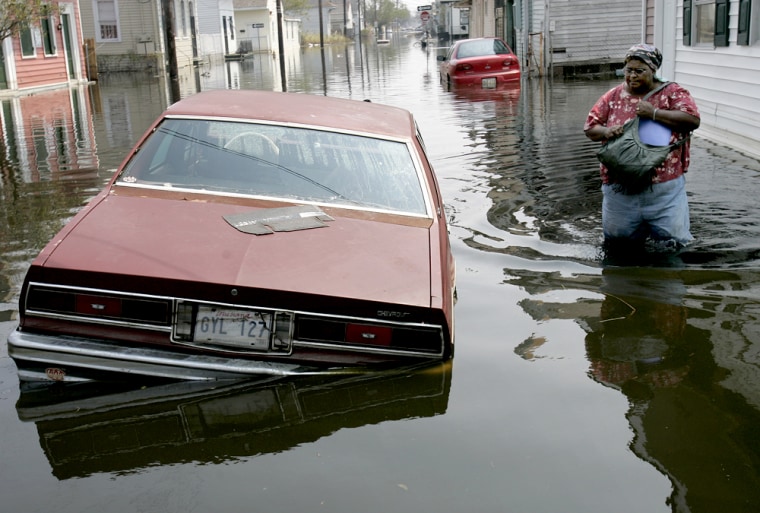As the Gulf Coast region struggles to return some semblance of normality after Katrina’s battering, consumer advocates are raising a new alarm: Thousands of cars soaked by the hurricane are expected to enter the U.S. car market over the next few months and could be snapped up as bargains by unsuspecting buyers.
Each year, as severe weather ravages the Midwest, southern and coastal areas of the United States, thousands of cars are damaged or destroyed by floods. Most of these so-called "storm cars" are usually sold for parts, but others make their way into the hands of dishonest people who try to fix them and pass them on to unwitting consumers in other states, or sometimes overseas, without disclosing that they have been damaged by flooding.
While it’s too early to have solid numbers, the destruction path left by Hurricane Katrina is likely to lead to flood damage to tens of thousands of cars, notes Robert Hartwig, chief economist with the Insurance Information Institute in New York.
“This is arguably one of the largest flood events in U.S. history, and so car consumers should be more vigilant in the months to come as there could be large number of these vehicles in the market,” said Hartwig. “They usually turn up for sale in the areas where a disaster occurs, but they can also be transported for sale anywhere in the United States.”
Flood damaged cars can often be restored to working order, but they can have mechanical problems for years afterward. In fact, flood damage can lead to serious problems, including the malfunction of headlights, windshield wipers, brakes and even airbags, and so many insurance adjusters simply write off a vehicle if it has been flooded above its dashboard where most of its electronic components are housed.
But there is a market for flooded cars. They are often sold for parts and buyers are attracted to them because once the damage is disclosed their value drops dramatically.
The problem comes when the flood damage is not disclosed, as is required by law in each state, usually because fraudsters have tampered with a car’s paperwork. They can take a car damaged in one state and sell it in another state with brand new ownership documentation.
After last year’s bout of hurricanes, many flood-damaged cars were patched up, refurbished and issued with new documents, industry observers say. These vehicles were sold to unsuspecting consumers without full disclosure of their damage history. In 1999, for example, over half of the estimated 75,000 flood-damaged vehicles from Hurricane Floyd returned to the road, according to Carfax, which provides car consumers with vehicle history reports.
What to watch for
Although damaged vehicles from Hurricane Katrina may take a while to hit the market, car consumers would do well to acquaint themselves of the best ways to spot potentially-flooded cars, according to Robert Sinclair Jr., a spokesperson for the Automobile Club of New York, a local division of AAA.
Sinclair says car buyers should first check a vehicle’s complete history using a service, like Carfax — which traces a vehicle’s histories through vehicle identification numbers, or VINs — to see if it has sustained substantial water damage in the past. However, unless a car was considered too damaged to repair, its history might not indicated it sustained water damage. And as flood damage can often go unnoticed by an untrained eye, it’s also important to have the vehicle examined by a fully-qualified mechanic, Sinclair adds.
A car buyer’s nose is also useful for spotting a water-damaged car. A musty smell, caused by mold or mildew, can often indicate water damage in the past, as can dried mud or residue under the dashboard. It’s also important to check for rust on the inside of the car, or for a recently replaced carpet or upholstery, as these areas of the car should last for many years without replacement.
“Personally, I’d be leery about dealing with a car damaged by flood, especially the newer cars that are more festooned with electronic controls, and so more likely to be damaged,” said Sinclair. “And particularly if it was damaged by salt water, as that’s especially corrosive.”
The Insurance Information Institute expects to see at least $100 million worth of motor vehicle claims as a result of Katrina, according to Hartwig. “That was the case in Florida last year after their storms, and the flooding this year in Mississippi and Louisiana was worse,” he said.
But this year fewer cars could make their way to used car lots, according to A. Jayson Adair, president of California-based Copart Auto Auctions, which provides auctions for salvaged vehicles. Adair’s company is now engaged in clearing flood-damaged cars and other vehicles from highly-impacted areas in Louisiana, Mississippi and Alabama. But he doesn’t expect many of the cars he salvages to be repairable in any shape or form.
“I don’t know what people could do with these vehicles,” he said. “This isn’t like hurricanes in years past when you get a flash flood and a car is under water for a few hours. Some of these vehicles have been under water for days, and many of the ones we have already pulled out of the water are completely ruined, and so we’ll take them straight to the crusher. The others we can use we’ll probably just sell for parts.”
